Stains appear after washing in the washing machine
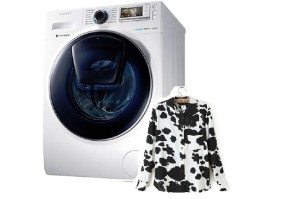 There are stains on the laundry after washing in the washing machine! It sounds somehow implausible, because a washing machine should wash things, and not contaminate them. Nevertheless, such a situation is not at all uncommon and in most cases this happens to the owners of rather old “home assistants” who have served for 5, 10, or even 15 years. Why the washing machine leaves stains, making things dirty, this issue must be understood.
There are stains on the laundry after washing in the washing machine! It sounds somehow implausible, because a washing machine should wash things, and not contaminate them. Nevertheless, such a situation is not at all uncommon and in most cases this happens to the owners of rather old “home assistants” who have served for 5, 10, or even 15 years. Why the washing machine leaves stains, making things dirty, this issue must be understood.
Why does the machine not wash, but contaminate the laundry?
Indeed, the situation is more than strange. The machine washed clothes regularly for many years, and then suddenly “revolted”, went into opposition and began to pollute the laundry. It’s a little strange, don’t you think? Meanwhile, there is nothing strange in this. The machine naturally stains the laundry, not because the manufacturer intended it to, but for some good reason. And there are quite a lot of such reasons.
- Malfunctions in the bearing and oil seal.
- Dirt accumulated in and under the cuff.
- Mold accumulated on the drum, in the pipes.
- Dirty water.
- Poor quality washing powder.
Some reasons are more common, others less common, but they all deserve attention, and perhaps you have had to deal with one of them. All the reasons that lead to gray, brown, black or even green stains appearing on freshly washed clothes are caused by user errors, and in very rare cases we are talking about manufacturing defects. People simply run their washing machines, neglecting to take care of them.
Note! Only in 0.5% of cases, the cause of stains on clothes are defective factory seals and bearings.
Mold in the nozzles and powder cuvette
Poor and improper care of the washing machine can lead to the formation of a mold cap in the powder cuvette. This usually happens when the user, after washing, closes the hatch and cuvette of the machine, not allowing it to dry.. As you know, mold loves dampness, add heat here, and you get ideal conditions for the development of a whole cap of dangerous black mold, which releases harmful spores into the air. Where is mold most likely to grow inside a car?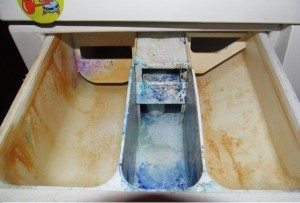
- In a powder cuvette.
- In the pipes going from the cuvette to the tank.
- On the walls of the drum.
- On the cuff.
- At the top of the tank on the walls.
If you have at least a normal sense of smell, then you simply cannot help but smell mold. It is enough to stick your head into the hatch a little and a sharp unpleasant smell will immediately hit your nostrils. This is a signal to inspect the machine parts more carefully. Do the following:
- bend the edge of the hatch cuff with your fingers and look into the gap;
- inspect the walls of the drum;
- open the powder cuvette and look inside;
- pull out the cuvette and look into the hole for it.
Chances are you'll quickly spot an ugly black cap growing and developing in your washing machine. If the laundry comes into contact with such a hat during washing, smeared black spots will remain on it.
For your information! Very often, black mold forms on and under the hatch cuff.
Mold must be removed immediately. Pour 150 g of soda into the powder cuvette and run a single wash at high temperature with an additional rinse. Baking soda and an aggressive washing cycle will help wash the mold clean. If this cannot be done at once, you can repeat the procedure.
The cuff is dirty or there are problems with the seal
Mold inside the machine is far from the only thing that stains things during washing. If for  The machine has not been looked after for several years; a thick dirty coating with a gray tint forms on the cuff and under it. During washing, things touch this coating and light dirty marks remain on them. And it happens that so much plaque forms that it begins to fall out of the grooves of the cuff during washing and settle in large gray spots on light-colored items - a terrible sight!
The machine has not been looked after for several years; a thick dirty coating with a gray tint forms on the cuff and under it. During washing, things touch this coating and light dirty marks remain on them. And it happens that so much plaque forms that it begins to fall out of the grooves of the cuff during washing and settle in large gray spots on light-colored items - a terrible sight!
What to do in this case? Everything is simple here, take a brush (regular and toothbrush), a rag and start dry cleaning the cuff. Remove gray plaque from everywhere, from every crack, the main thing is not to overdo it and do not damage the cuff.
Important! During cleaning, you should not use aggressive detergents based on alkali and acids, they can damage the cuff, and this will lead to a violation of the seal of the hatch.
If your washing machine leaves oil stains on your laundry, there may be a problem with the seals. The fact is that when the oil seals collapse, they begin to release lubricant into the tank, which in turn ends up on the laundry. This is a big problem that needs to be solved immediately, because if the seals are destroyed, not only will things become constantly dirty, it will also lead to water getting into the bearings. Water causes corrosion and very rapid corrosion of bearings.
You may have looked and the bearings are already broken. They give themselves away by creaking and grinding as the drum rotates. In both cases, you cannot wait; you need to immediately change both the seals and bearings. Bearing replacement and the seal of the washing machine is a rather complicated matter, so it is better to entrust it to a professional. Just think about it, you need:
- completely disassemble the machine;
- saw or untwist its tank;
- Correctly remove the old bearings and install new ones.
But if you are not afraid of difficulties and want to do the work yourself, go ahead, perhaps you will succeed, just be prepared for additional expenses.
Or maybe the reason is the washing powder or dirty water?
 You think that the washing machine leaves dirt on your clothes, but it may not be at all! The cause of stains may lie in low-quality washing powder. You may object that I have been constantly washing with the same powder for several years, and before everything was fine with my laundry. In fact, washing with the same powder does not guarantee its consistent quality. You can buy a fake, you can buy a pack of powder from a defective batch, in general, anything can happen.
You think that the washing machine leaves dirt on your clothes, but it may not be at all! The cause of stains may lie in low-quality washing powder. You may object that I have been constantly washing with the same powder for several years, and before everything was fine with my laundry. In fact, washing with the same powder does not guarantee its consistent quality. You can buy a fake, you can buy a pack of powder from a defective batch, in general, anything can happen.
If you suspect that something is wrong with the powder, try washing a second load of laundry with a different powder or even a liquid detergent. If there are no stains left on the laundry, then the problem could really be in the powder. Also, the problem with the powder is revealed by the nature of the stains. If spots:
- Green colour;
- reddish;
- light brown;
- white (on dark underwear).
Note! Sometimes low-quality powder leaves colorful rainbow spots on clothes. If this happens to you, don’t doubt it’s powder.
Most likely, you really need to change the powder, although to be sure, you need to check everything again. Bad washing powder, which can leave marks on clothes, can be identified by the following signs.
- It is poorly soluble in water, undissolved granules are present on clothes after washing, and a lot of undissolved product remains in the powder cuvette.
- A good automatic washing powder produces a moderate amount of foam; if the powder does not produce foam or too much foam, it is not suitable for washing.
- After washing clothes with such a powder, they acquire a sharp, unpleasant chemical smell that does not disappear for a long time; such a powder cannot be used.
The quality of our tap water leaves much to be desired, and when carrying out plumbing repairs (replacing pipes), it is better not to use a washing machine or dishwasher at all. Experts recommend opening the cold water tap before starting the washing machine. If dirty, rusty water with small debris comes out of the tap, it is better to refrain from washing for a couple of hours. Wait until the water is relatively clear again before starting the washing machine.
It is not uncommon for all the white clothes that were put in the washing drum to spoil due to dirty tap water. And if you consider that it is very difficult to remove rust stains, then think for yourself whether it is worth checking the quality of the water every time before washing or not.
Interesting:
Reader comments
- Share your opinion - leave a comment

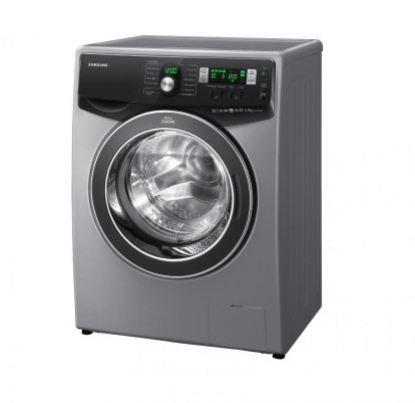

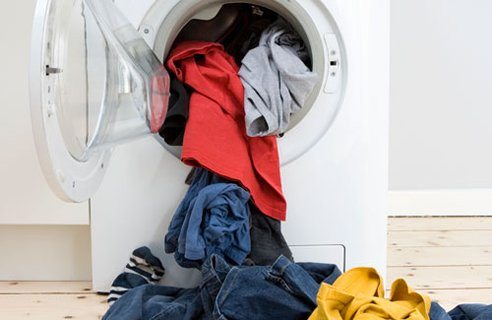
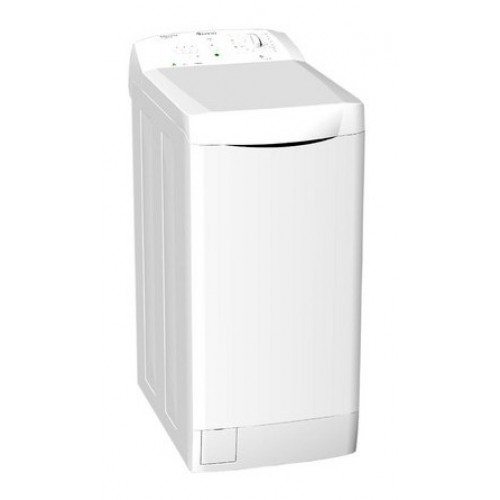

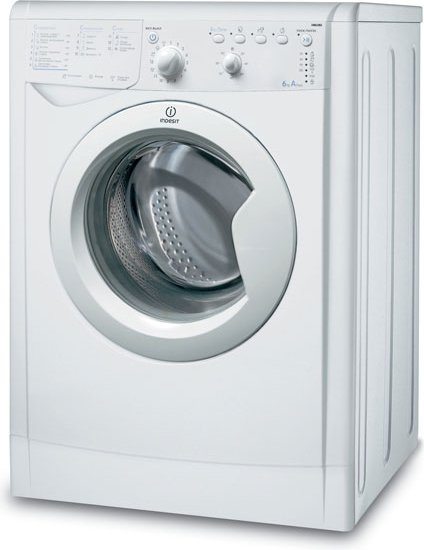














Add a comment